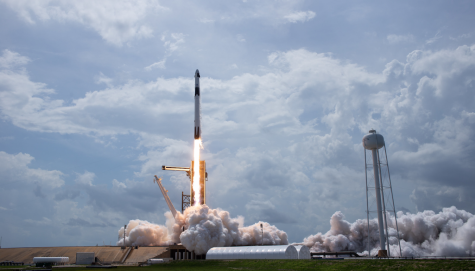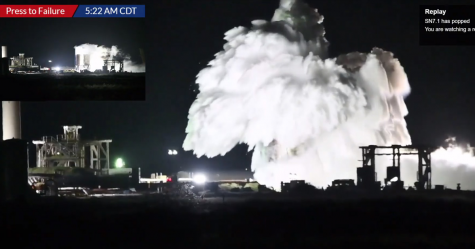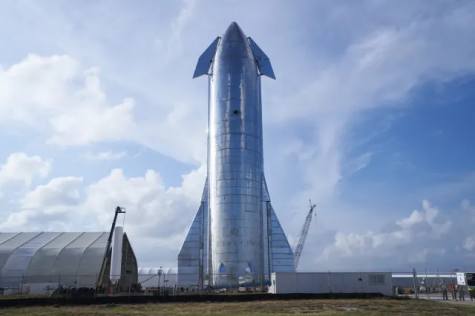
By Harrison York | Head Editor
September 25, 2020
Perhaps the greatest contender in the reignition of the space race, SpaceX, founded in 2002 by Elon Musk, has quickly developed advanced rocketry technologies, enabling the company to find success in the growing industry.
On May 30, SpaceX launched NASA astronauts Doug Hurley and Bob Behnken to the International Space Station aboard their Falcon 9 rocket. The first American launch to the ISS from American soil since 2011, and the first manned-mission by a private, commercial company, this event proved that SpaceX—and the private sector in general—is capable of carrying humanity into space. The two astronauts returned to Earth on August second, safely splashing down in the Gulf of Mexico near Florida.
“I do think what this heralds really is fundamentally a new era in spaceflight,” SpaceX founder and CEO Elon Musk later said. “We’re going to go to the moon, we’re going to have a base on the moon, we’re going to send people to Mars and make life multiplanetary.”
Their most recent launch took place in early September, setting 60 Starlink satellites in low Earth orbit. This was the twelfth successful launch of Starlink satellites, which will eventually be able to provide internet access to regions where connections are limited or nonexistent. So far, about 650 such satellites have been launched.
This year, SpaceX had 16 successful launches, with estimates to have up to 24 missions by the end of 2020. In the company’s lifetime, their most popular rocket, the Falcon 9, has had 92 total launches and 53 total landings. These landings are essential in making space exploration a profitable business, and it has been both challenging and rewarding for the company.
38 Falcon 9 missions have been completed using re-flown rockets—a money-saver for SpaceX and their partners. In considering the future of affordable spaceflight, Musk often compares rockets to airplanes and other established forms of transportation. “The key to opening up space is rapid and complete reusability or near-complete reusability, like we have with aircraft or cars,” Musk said in an interview with CNBC.
In this future, however, SpaceX plans to use a new rocket capable of traveling to the moon, Mars, and out into the solar system. Considered “the top SpaceX priority,” Starship is designed to be fully reusable and carry both cargo and crew on missions. Testing is already underway in Boca Chica, Texas, where, on August 4, prototype SN5 “hopped,” soaring to 150 meters before touching back down. Soon after, SN6 underwent a similar test on September 3, with Musk describing it as “a much smoother and faster operation.”
Just this week, SpaceX pushed a Starship test tank to its limits, intentionally causing the tank to burst after filling it with cryogenic fuel. Exploding early Thursday morning, the event was the culmination of three nights of intense experimentation. Plans for a high-altitude test of yet another prototype—SN8—are in full swing as the rocket, now with a nose cone and flaps, is expected to launch up to 60,000 feet within the coming days.

SpaceX aims to send Starship to the moon as early as 2022, delivering rovers and other equipment for NASA. The same year, the company hopes to launch an unmanned mission to Mars, with goals for a crewed launch in 2024. Additionally, in 2023, art curator Yusaku Maezawa is set to fly by the moon in what will be the first private lunar passenger flight and an important step in funding Starship’s development.
The main goal of SpaceX has been to help make humanity a multi-planet species. “I think that space exploration is overall beneficial to humanity,” SCHS junior Max Banks said. “The pros outweigh the cons—like expenses and whatnot—because of the possibility of finding something amazing in space.”
“Space exploration is essential for the long-term survival of the species,” junior Ian McKernan said. “It will not only open up new habitats for humans, but also will allow us to access more resources on other planets.” Creating settlements on the moon and Mars will be important to combat overpopulation, and, in the far future, concepts like asteroid mining may become very real and vital sources of materials that are rare on Earth. The problems of tomorrow will be much different than the problems of today, and journeying out into the unknown could prove to be a possible solution ensuring the continuity of life.
Although an American company, SpaceX has partnered with numerous organizations and governments. This year alone, SpaceX has launched satellites for South Korea, Argentina, the European Space Agency, and several private companies, as well as for NASA in the spotlight mission to the ISS. “I think this is one of those things that is universally good, no matter where you are on planet Earth,” Musk said, referring to this milestone mission. His words, however, describe the endeavor of space exploration as a whole.
It is human nature to explore. We are curious and want to illuminate the dark unknown. SpaceX is spearheading this drive, preparing to venture far beyond the limits of the past and into the spacefaring future.

To watch SpaceX launches live, visit their channel. For more information about the company and future launches, go to spacex.com.

Leave a Reply